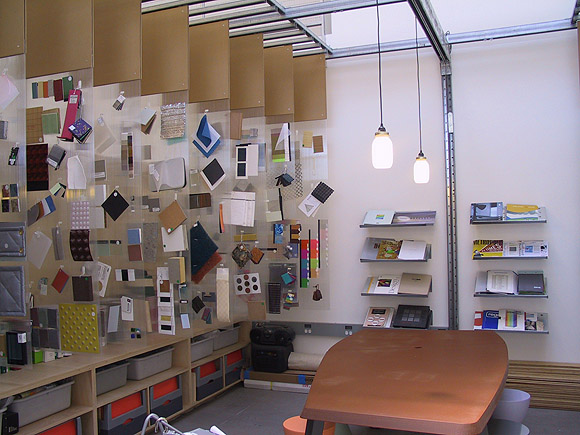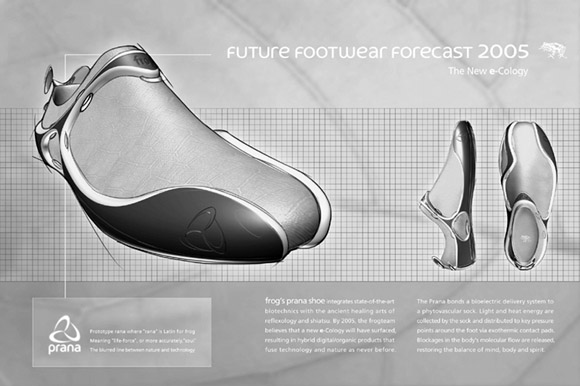Marcel Wanders, Airborne Snotty Vase, photo by Maarten Van Houten.
Take a look at many of the great pioneers in the design and architecture world, and more often than not you will see a thread of commonality: it’s an awareness and re-assimilation of materials science and sensibilities. By re-assimilation, I mean a sort of cross-pollination of materials and technologies among tangential industries. The Eameses were the first to shepherd bent plywood into the furniture and military industries with their now iconic chairs and splints. Michael McDonough, AIA, borrowing from nature’s toolbox, has found ways to conceive a wide variety of structures from unexpected natural resources like bamboo. Frank Gehry, FAIA, snatched fame with the application of aerospace technology and substrates; Gaetano Pesce with his goo; Marcel Wanders with something as commonplace as a sneeze. (His line of “snot” vases shocked and delighted the art world.)
Having been in the design consulting business for a decade and teaching college design classes for a few years, I’ve noticed a new guard of material rebels rise through the ranks. The fuel for their creativity is deeply seated in a hunger not only for new materials, but also new technologies and manufacturing processes that are hidden from commercial application. I believe the next wave of mega-designers will be defined even more by their ability to shift industry paradigms, solve consumer problems, and build sustainable business through new material and technology application. The challenge that I’ve run into in my own design pursuits is that there really isn’t a broad enough, deep enough, or centralized enough place to find this kind of inspiration. There have been a few attempts, one of the most noteworthy being the Material ConneXion in New York. (The problem with MC is that their library leans heavily on the architectural side of the materiality spectrum.)
There has also been an emergence of material acumen as a core competency of companies who rely on product innovation to sustain their bottom line. IDEO, a Palo Alto-based product development consultancy, has been amassing, over the past several years, what they call the Tech Box. It is literally a box, comprised of several flat files populated with the leftover gizmos, mechanisms, and material swatches from dozens of projects over the years. Over time, it has taken on a life of its own by becoming its own revenue source as well as providing inspiration for the resident designers and engineers. Realizing the scarcity of this resource, IDEO has begun hiring out its Tech Box to companies needing a dose of the vanguard. Nike is also a materials disciple, with a textile library so large it has a dedicated staff to manage it.
All of these companies are on to something, but they are coming up short, short on variety and, in many cases, accessibility for the design community as a whole. During my tenure at CCAC (California College of Arts and Crafts), with the benefit of a small grant and even smaller task force, we decided to take a stab at our own materials culture. We spent a fair bit of time defining the theoretical framework that would be used to develop systems of collecting, evaluating, organizing, and growing what we felt would be an invaluable New Materials Reference Library for the creative spirit. We devised ways to build a critical mass of goods through the Bay Area community. We worked our way into the studios of our friends and associates with their disheveled drawers of samples and illegible Rolodexes of curious things. By helping local design offices organize and catalog their boxes of goodies, we were able to build substantial critical mass in relatively short order for the school. After that, we slated interns to scour a slew of industry rags and tech-journals, siphoning out all the good stuff and researching the genesis of the lead. We earmarked tradeshows that ranged from aerospace to biotech. Moreover, we schemed on how to partner with laboratories such as Lawrence Livermore and MIT to get hold of the white papers they publish on new and emerging tech. Lastly, we went after petrochemical companies like Bayer and BASF, who have a war chest of material technologies but lack the budget to market them to the design community.

Once collected, the challenge turned to organization. We developed a database that allows multiple points of entry, depending on how you want to search for things. Additionally, we created a storage system that doubles as a display system. We wanted to create a space with an organized intellect and a spontaneous nervous system. One person would enter the space and go directly to the computer for a keyword search, another would decide to spend an hour (or ten) in the visual presence of dozens of floor to ceiling panels loaded with eye candy.
You wouldn’t believe the stuff we dug up collecting dust in nameless attics. I’m talking about self-healing, microcapsule plastics developed by Scott White at the University of Illinois. Or transgenic spider webs, engineered at Nexia Biotechnologies, that are soft as silk, lighter than cotton, and stronger than Kevlar. There is a techno-gel-foaming-alloy-biomimicry- playground out there, and we wanted in.*
Now What?
After a ten-year tour of some of the top product development firms in the U.S., I’ve decided to move out of the world of design and into the world of invention. What separates the two? Semantically speaking, not much. But connecting new business and new materials through design feels more inventive than consulting on someone else’s brainchild, at least to me. The level of innovation behind self-initiated concepts, coupled with the freedom from work-for-hire projects, has been fertile ground for new ventures. Instead of a project being orchestrated with a basic desire to please the client first and then the consumer, my projects have been reverse-engineered, starting with the technology, and from there figuring out where the consumer could gain most from its implementation.
For a glimpse of some “material re-assimilation” in action, I’ll start with a stretch of the imagination and work my way down to a “Why didn’t I think of that?” scenario.
Sole Food
Prana was a future footware concept commissioned by SF MOMA. They asked frogdesign to look five years into the future and take a stab at the state of sneakers. Well, if we had anything to say about it, we would be making these babies ourselves. The concept integrates all sorts of new and emerging technologies. We focused on the synergy of state-of-the-art biotechnics and grounded it in the ancient healing arts of reflexology and shiatsu. We suggested that, in 2005, a new ecology would start to surface, resulting in hybrid digital/ organic products that fuse technology and nature. Prana bonds a bioelectric delivery system to a phytovascular sock. Light and heat energy are collected by the sock and distributed to key pressure points around the foot via exothermic piezo ceramic pads. Blockages in the body’s molecular flow are released, restoring the balance of mind, body, and spirit.

Slick Sound

JBL gave Ashcraft carte blanche in 1993. They said, “We want innovation! Do anything you want to reinvent our loud speakers… as long as they are made from black, vinyl-wrapped MDF.” And so it goes, the long series of debates, defending and eventually translating innovation into brand differentiation, into market share, into profit. I got pretty good at all the shoptalk, and on occasion was persuasive enough to get the client to take a gamble. This product, in particular, was a favorite that only made it to the EU market. It’s about as far from a mitered vinyl box as you can get. In order to invent a product that felt more like furniture—i.e., a lamp—we went outside the traditional loudspeaker market to identify new manufacturing and material technologies. The drivers are incased in a roto-molded torpedo, which, in turn, is stretched with a Lycra sock and stuffed into a deep spun, aluminum cone. We landed on a fully integrated design/engineering solution that solved some stubborn acoustical reverberation and heat sync problems. The resulting product is as easy on the eyes as it is on the ears.
Air Flow
I subscribe to the notion that opportunity doesn’t need to be created, just recognized. The Flow bicycle saddle was a simple product that fell out of an intuitive, connect-the-dots exercise. It drew a line between a technology that has had great acclaim in office seating, with the Herman Miller Aeron chair, and applied it to an industry that hasn’t seen an innovative leap in 100 years: the bicycle seat. It’s the first bicycle saddle that effectively dissipates a rider’s weight, with the added benefit of superior ventilation through the use of an elastomeric- encapsulation-molded textile. First an idea, then a product, and now a company (Saddleco) are born. It was as easy as falling off a bike.
Ultimately, there are a myriad of takes on design philosophy. For me, taking a lead in the exploration of new technologies and finding creative forms for their use has been a calling born from passion, a passion for evolution, albeit consumer product in focus. I would suggest—actually, I would encourage—any creative individuals who want to amplify their art and deepen their message to keep their eyes peeled and their minds open. Chances are there is a material right under your nose that is looking for a little form.

*Editor’s note: for more on “biomimicry,” see Janine M. Benyus, Biomimicry: Innovation Inspired by Nature (New York: Quill, 1998).
Author Tylor Garland is founding principal of boomBang, a creative incubator that develops, patents, and solicits venture capital to build enterprises around innovative products that are informed by new and emerging materials and technologies. He was previously Managing Director of Product Development for frogdesign.
Originally published 4th quarter 2002, in arcCA 02.4, “New Material.”






